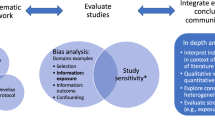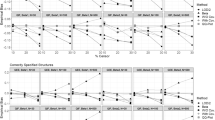Abstract
In this paper, we develop models of bias in estimates of exposure–disease associations for epidemiological studies that use group- and individual-based exposure assessments. In a study that uses a group-based exposure assessment, individuals are grouped according to shared attributes, such as job title or work area, and assigned an exposure score, usually the mean of some concentration measurements made on samples drawn from the group. We considered bias in the estimation of exposure effects in the context of both linear and logistic regression disease models, and the classical measurement error in the exposure model. To understand group-based exposure assessment, we introduced a quasi-Berkson error structure that can be justified with a moderate number of exposure measurements from each group. In the quasi-Berkson error structure, the true value is equal to the observed one plus error, and the error is not independent of the observed value. The bias in estimates with individual-based assessment depends on all variance components in the exposure model and is smaller when the between-group and between-subject variances are large. In group-based exposure assessment, group means can be assumed to be either fixed or random effects. Regardless of this assumption, the behavior of estimates is similar: the estimates of regression coefficients were less attenuated with a large sample size used to estimate group means, when between-subject variability was small and the spread between group means was large. However, if groups are considered to be random effects, bias is present, even with large number of measurements from each group. This does not occur when group effects are treated as fixed. We illustrate these models in analyses of the associations between exposure to magnetic fields and cancer mortality among electric utility workers and respiratory symptoms due to carbon black.
This is a preview of subscription content, access via your institution
Access options
Subscribe to this journal
Receive 6 print issues and online access
$259.00 per year
only $43.17 per issue
Buy this article
- Purchase on Springer Link
- Instant access to full article PDF
Prices may be subject to local taxes which are calculated during checkout

Similar content being viewed by others
References
Berkson J. Are there two regressions? Am Stat Assoc 1950: 45: 164–180.
Burr D. On errors-in-variables in binary regression -Berkson case. J Am Stat Assoc Theory Methods 1988: 83 (403): 739–743.
Carroll R.J., Ruppert D., Stefanski L.A., and Crainiceanu C.M. Measurement Error in Nonlinear Models (A Modern Perspective). CRC, Chapman & Hall, Boca Raton, 2006.
Chambers J., and Hastie T.J. Statistical Models in S. Wadsworth & Brook/Cole, Pacific Grove, CA, USA, 1991.
Gardiner K., Calvert I.A., van Tongeren M., and Harrington J.M. Occupational exposure to carbon black in its manufacture: data from 1987 to 1992. Ann Occup Hyg 1996: 40: 65–77.
Gardiner K., Threthowan N.W., Harrington J.M., Rossiter C.E., and Calvert I.A. Respiratory health effects of carbon black. A survey of European carbon black workers. Br J Ind Med 1993: 50: 1082–1096.
Gardiner K., van Tongeren M., and Harrington J.M. Respiratory Health Effects from Exposure to Carbon Black: Results of the Phase II and III Cross-sectional Studies in the European Carbon Black Manufacturing Industry. Occup Environ Med 2001: 58: 496–503.
Goldstein H. Multilevel Statistical Models. Kendalls Library of Statistics, New York, 2003: 3.
Gustafson P. Measurement Error and Misclassification in Statistics and Epidemiology. CRC, Chapman & Hall, Boca Raton, 2003, pp. 139–147.
Harville D.A. Maximum likelihood approaches to variance component estimation and to related problems. J Am Stat Assoc 1977: 72: 320–340.
Kim H.M., Yasui Y., and Burstyn I. Attenuation in risk estimates in logistic and Cox models due to group-based exposure assessment strategy. Ann Occup Hyg 2006: 50 (6): 623–635.
Kromhout H., Loomis D., and Kleckner R.C. Uncertainty in the relation between exposure to magnetic fields and brain cancer due to assessment and assignment of exposure and analytical method in dose-response modeling. Ann NY Acad Sci 1999: 895: 141–155.
Kromhout H., Loomis D., Mihlan G.J., Peipins L.A., Kleckner R.C., Iriye R., and Savitz D.A. Assessment and grouping of occupational magnetic field exposure in five electric utility companies. Scand J Work Environ Health 1995: 21 (1): 43–50.
Kromhout H., Symanski E., and Rappaport S.M. A comprehensive evaluation of within and between-worker components of occupational exposure to chemical agents. Ann Occup Hyg 1993: 37: 253–270.
Loomis D., Kromhout H., Peipins L.A., Kleckner R.C., Iriye R., and Savitz D.A. Sampling design and methods of a large randomized, multi-stage survey of occupational magnetic filed exposure. Appl Occup Environ Hyg 1994: 9: 49–52.
Loomis D., and Kromhout H. Exposure Variability: concept and applications in occupational epidemiology. Am J Ind Med 2004: 45: 113–122.
Rappaport S.M., and Kupper L.L. Quantitative Exposure Assessment. Stephen Rappaport, El Cerrito, CA, USA, 2008, pp. 122–125.
Reeves G.K., Cox D.R., Darby S.C., and Whittey E. Some aspects of measurement error in explanatory variables for continuous and binary regression models. Stat Med 1998: 17: 2157–2177.
Saviz D.A., and Loomis D. Magnetic field exposure in relation to leukemia and brain cancer mortality among electric utility workers. Am J Epidemiol 1995: 141: 123–134.
Tielemans E., Kupper L., Kromhout H., Heederik D., and Houba R. Individual-based and group-based occupational exposure assessment: some equations to evaluate different strategies. Ann Occup Hyg 1998: 42 (2): 115–119.
van Tongeren M., Burstyn I., Kromhout H., and Gardiner K. Are variance components of exposure heterogeneous between time periods and factories in the European carbon black industry? Ann Occup Hyg 2006: 50: 55–64.
van Tongeren M., Gardiner K., Calvert I., and Kromhout H. Efficiency of different grouping schemes for dust exposure in the European carbon black respiratory morbidity study. Occup Environ Med 1997: 54: 714–719.
Wang N., Lin X., Gutierrez R.G., and Carroll R.J. Bias analysis and SIMEX approach in generalized linear mixed measurement error models. J Am Stat Assoc Theory Methods 1998: 93 (441): 249–261.
Wang N., Lin X., and Gutierrez R.G. A bias correction regression calibration approach in generalized linear mixed measurement error model. Commun Stat A Theory Method 2000: 28: 217–232.
Weinberg C.R., and Umbach D.M. Using pooled exposure assessment to improve efficiency in case-control studies. Biometrics 1999: 55 (3): 718–726.
Acknowledgements
Hyang-Mi Kim is thankful to David Richardson and Dana Loomis for their hospitality during her stay at the University of North Carolina, Chapel Hill, USA. Drs Richardson and Loomis were supported by grant R01-CA117841 from the National Cancer Institute, National Institutes of Health. Igor Burstyn was supported by salary awards from the Canadian Institutes for Health Research and the Alberta Heritage Foundation for Medical Research.
Author information
Authors and Affiliations
Corresponding author
Ethics declarations
Competing interests
The authors declare no conflict of interest.
Rights and permissions
About this article
Cite this article
Kim, HM., Richardson, D., Loomis, D. et al. Bias in the estimation of exposure effects with individual- or group-based exposure assessment. J Expo Sci Environ Epidemiol 21, 212–221 (2011). https://doi.org/10.1038/jes.2009.74
Received:
Accepted:
Published:
Issue Date:
DOI: https://doi.org/10.1038/jes.2009.74
Keywords
This article is cited by
-
Exposure to benzene and other hydrocarbons and risk of bladder cancer among male offshore petroleum workers
British Journal of Cancer (2023)
-
Systematische Fehler in klinischen Studien
Pneumo News (2019)
-
Systematische Fehler in klinischen Studien
Zeitschrift für Rheumatologie (2017)
-
Systematische Fehler in klinischen Studien
Der Ophthalmologe (2017)
-
Systematische Fehler in klinischen Studien
Der Pneumologe (2017)



